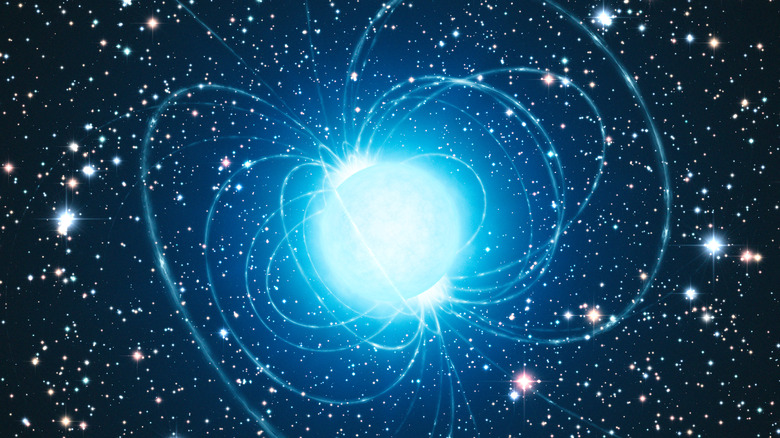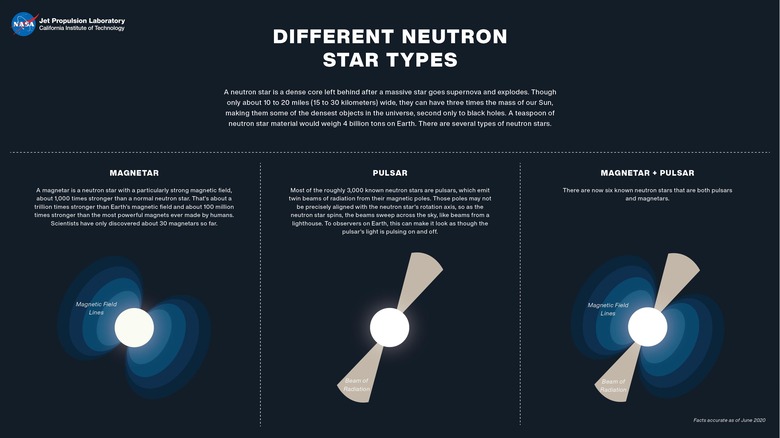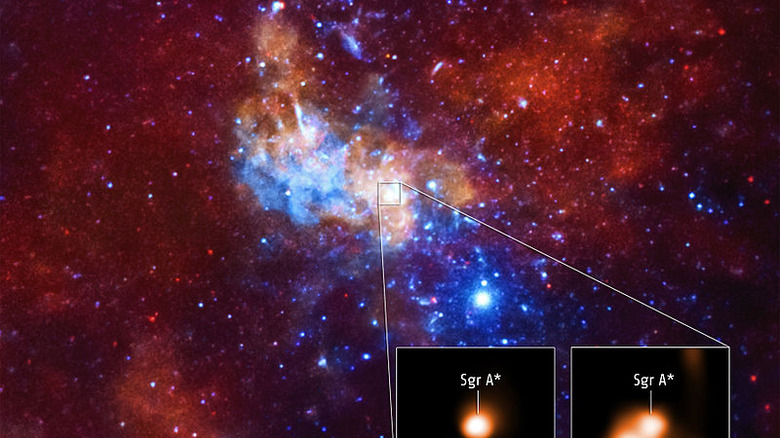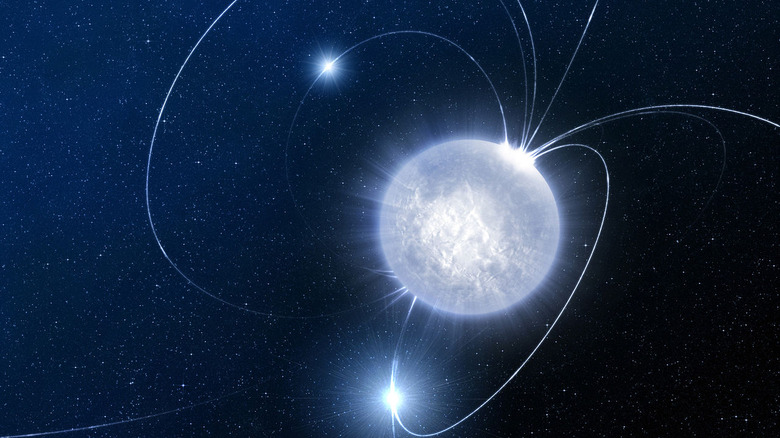Magnetars Are The Universe's Supervillain Weapon
Space is unbelievably cool, mysterious, and very dangerous. In fact, it just might be the most hostile place imaginable, given how there are things like black holes, quasars, and neutron stars in the cosmos. Cosmologists — basically space scientists — and astrophysicists spend the bulk of their lives attempting to unravel the mysteries of the known and unknown universe. And while science has made great strides in the past, there are many things about space that are still shrouded in mystery.
One phenomenon that provokes both intrigue and absolute nightmare fuel is the magnetar. The magnetar is one of the most violent and dangerous objects in all of the universe. As Ars Technica explains, a magnetar is essentially the corpse of a dead star. This stellar corpse possesses a magnetic field so powerful that it can pulverize the atoms of anything and everyone from thousands of miles away. As stated by Space, magnetars are what remain after a supernova event, which outputs some of the most dangerous objects in existence. But before getting into that, there are a few things about neutron stars one should know.
What are neutron stars?
Before getting into magnetars, let's look at the properties of neutron stars and how they're formed. For that, one must look at how stars live and die. Stars come in different types of sizes, like neutron stars, brown dwarfs, supergiants, and more (via Space). These are first created in hydrogen and helium clouds, which form stars after their gravitational pull causes them to collapse in on themselves. These clouds then generate extreme temperatures, creating and igniting the necessary material for star formation.
As explained by NASA, the process of neutron star creation is somewhat similar but with major differences. Eventually, giant stars will run out of fuel, much like a car. Except when a star runs out of fuel, its own gravity causes it to collapse in on itself. This collapse is so extreme and volatile that all electrons and protons in the star are smashed together, creating neutrons. And what's left behind is a neutron star.
What are magnetars?
There are actually several types of neutron stars, including magnetars, pulsars, and pulsars-magnetar hybrids, according to NASA. And while there are some similarities, magnetars differ from pulsars in a few ways. For starters, of the neutron stars scientists have discovered, most of them tend to be pulsars, with magnetars being rarer. per NASA, pulsars get their name from the radiation beams that pulsate around the star "like beams from a lighthouse."
Magnetars, on the other hand, do not have these pulsating beams but instead have insanely powerful magnetic fields. These fields are over a trillion times more powerful than the magnetic field on Earth and can pulverize objects from thousands of miles away. As Space says, magnetars have pretty freaky and scary science beneath the hood. In fact, if one were just 600 miles away from a magnetar, they would be instantly pulverized and disassembled molecule by molecule.
Why magnetars are so scary
Even though people have already caught a glimpse of just how scary the universe is, there are far more frightening things lurking in the vast darkness. People know of black holes, but magnetars are just as powerful and are truly the stuff of nightmares. For one, magnetars are the most powerfully magnetic thing in the known universe, according to Space. What makes them truly frightening is what happens at the molecular level when something is caught in their fields. Think of a blender, but worse — much worse. Everything subatomic gets pulverized into nothing.
Scientists are still not entirely sure why magnetars are this ridiculously strong and magnetic, but they have a few guesses. As Phys.org notes, magnetars might need the perfect conditions to form, which might be why many neutron stars don't form into them. A neutron star's magnetic field, spin, and temperature all need to be set at just the right conditions to create such an extremely exotic magnetic field.
Scientists have only found 31 magnetars so far
Magnetars are pretty much apocalyptic world-ending forces of nature that, thankfully, people don't have to worry about too much. Why is that? Well, for starters, magnetars seem to be ridiculously far away. As Syfy explains, one of the nearest magnetars, XTE J1810-197, is around 8,000 lightyears away from Earth. And while that may not seem very close, it's much closer than many others. Remember, a light year is a bit over 5.865 trillion miles long (via HowStuffWorks), so it is highly unlikely that a magnetar will affect the Earth dramatically anytime soon.
Another thing to keep in mind is that magnetars also tend to be fairly rare. According to Universe Today, scientists have only discovered 31 magnetars to date. Even rarer are magnetar-pulsar stars, of which only 5 have so far been discovered. Given how exotic and delicate the conditions for creating a magnetar are, this isn't too surprising.
Magnetars have very short lifespans and drain matter
While magnetars pose one of the greatest threats in the known cosmos to any object or person, that threat is somewhat short lived. As Space says, magnetars in general only live for about 10,000 years or so. The science on why this is the case is still nebulous, but the exotic material of a magnetar might be a contributing factor to why it eventually deteriorates into a regular neutron star.
As Interesting Engineering explains, magnetars often feed from neighboring matter in order to gain even more power. Star-quakes are also vital in how magnetars gain more magnetic power (they are basically similar to an earthquake, only caused in space). These usually result in an immense energy burst, or gamma-ray burst. Magnetars basically consume material for thousands of years until they quietly settle into a less powerful state. As science learns more about the universe, there may yet be more information discovered about magnetars. But until then, they will remain frightening, mysterious entities hanging in the void of space.





